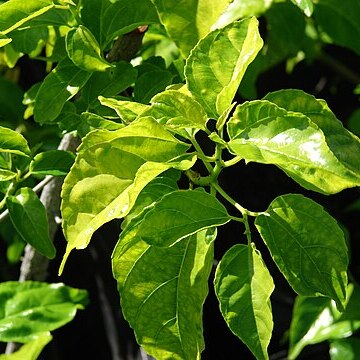Trees, shrubs, or scandent shrubs, deciduous or evergreen, always unarmed. Leaves alternate to rarely opposite, papery to subleathery; stipules minute, early deciduous; margin entire, serrate or crenate; venation pinnate or 3-veined from base. Flowers bisexual, 5-merous, mainly few in axillary cymes or small thyrses, sessile or shortly pedunculate. Calyx tube hemisperical; sepals 5, triangular, abaxially rather densely pubescent, adaxially conspicuously keeled, deciduous. Petals 5, erect to spreading, clawed. Stamens 5, ca. as long as petals; anthers dorsifixed, dehiscing introrsely. Disk massive, fleshy, adnate to calyx tube. Ovary semi-inferior, 3(or 4)-loculed, with 1 ovule per locule; style 3-lobed to 3-fid. Fruit a subglobose capsule; mesocarp thin, dry or rather fleshy; endocarp cartilaginous to woody, splitting explosively or slowly into 3 ventrally dehiscent, 1-seeded endocarpids. Seeds shiny, broadly obovoid, rarely with a minute aril; testa leathery to bony; endosperm fleshy, thick.
Unarmed (or rarely armed but not in Africa) trees and shrubs, rarely scandent (as in the present species) but never a liane or twiner. Leaves alternate (or opposite but not in Africa). Stipules present, rarely (never in Africa) interpetiolar. Flowers bisexual, protandrous, 5-merous, in small axillary thyrses or fascicles. Disk massive and nearly completely surrounding the ovary. Ovary at anthesis inferior but later by differential growth becoming at least half superior. Cup and disk accrescent and persistently coherent to the 3(4)-celled ovary, at maturity covering the lower sixth to half of the fruit and at dehiscence breaking away ± irregularly along with the dryish (not spongy) exocarp, the 3 remnants adhering to the 3 crustaceous 1-seeded endo-mericarps which separate completely from each other, each releasing its seed through a longitudinal ventral slit.
Shrubs or trees, unarmed [armed with thorns]; bud scales present at least on short shoots. Leaves persistent or deciduous, alternate [opposite], sometimes fascicled on short shoots; blade not gland-dotted; pinnately veined or 3-veined from base (acrodromous). Inflorescences axillary, usually cymes, thyrses, or fascicles, rarely flowers solitary; peduncles and pedicels not fleshy in fruit. Pedicels present. Flowers bisexual; hypanthium hemispheric, 2–3 mm wide; sepals 5, spreading, brown to greenish, ovate-triangular to triangular, keeled adaxially; petals 5, greenish or yellowish to creamy white, ± hooded, spatulate or obovate, clawed; nectary fleshy, adnate to and sometimes ± filling hypanthium; stamens 5; ovary 1/2-inferior to inferior, 3(–4)-locular; styles 3, connate proximally. Fruits capsules, sometimes tardily dehiscent, 3-locular.
Scandent shrubs, lianes or trees. Leaves alternate, subopposite or opposite, petiolate, concolorous, penniveinved or tripliveined from base; stipules free. Inflorescences axillary, few-flowered branching rhipidia. Flowers greenish, bisexual, 5-merous. Hypanthium cup-to dish-shaped. Sepals spreading, caducous. Petals cucullate, obscurely clawed, erect or spreading. Stamens subequal to the petals, erect or spreading. Disc conspicuous, filling the hypanthium, smooth, glabrous. Ovary immersed in the disc; carpels 3 (or 4); style lobed or branched. Fruit a dry, globose, irregularly dehiscent capsule; torus basal or in the lower third; mericarps dehiscent. Seeds exarillate.
Leaves alternate, petiolate; lamina with serrulate margin, 3–5-nerved from base, penninerved distally; stipules small, deciduous.
Capsule ± spherical, dehiscing septicidally into 3 cocci; exocarp thin and not fleshy.
Ovary immersed in the disk and ± fused with it, 3(4)-locular; style 3(4)-fid.
Petals 5, cucullate, unguiculate, inserted below the disk.
Flower bisexual, pedicellate.
Receptacle hemispherical.
Shrubs or trees, unarmed.
Seeds 3-gonous.
Cymes axillary.
Disk fleshy.
Stamens 5.
Sepals 5.

